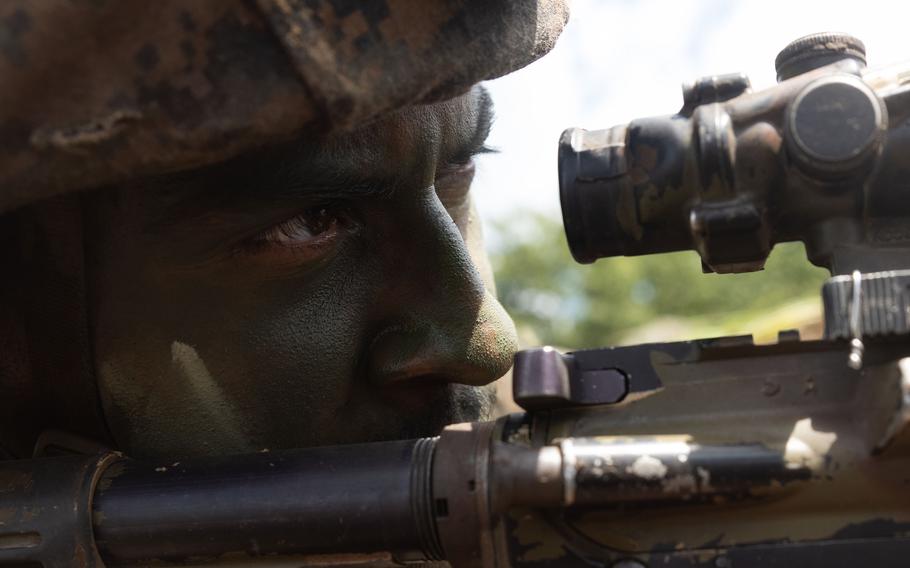
An American service member aims an M4 carbine during Resolute Dragon training in Otia prefecture, Japan, Aug. 1, 2024. (Adam Trump/U.S. Marine Corps)
CAMP COURTNEY, Okinawa — U.S. and Japanese military officials touted the Marine Corps’ newest littoral unit, new radar technology and the countries’ alliance during a ceremony marking the close of joint drills Wednesday.
Lt. Gen. Roger Turner, commander of the III Marine Expeditionary Force, and Lt. Gen. Masayoshi Arai, head of Japan’s Western Army, addressed about 100 U.S. Marines, U.S. soldiers and Japanese troops in front of III MEF headquarters. The event closed out this year’s Resolute Dragon, which spanned three prefectures in southern Japan, including Okinawa.
The fourth iteration of the annual exercise featured the 12th Marine Littoral Regiment’s operational debut. The unit launched in November to specialize in stand-in force operations — a key tenet of the island-fighting doctrine featured in the Marines’ Force Design plan.
“This also marked a major advancement in our ability to deter and defend against any threat in key maritime areas, while enhancing our capability to provide humanitarian aid to remote islands as a unified and bilateral force,” Turner said at the ceremony.
A stand-in force is a small, mobile unit inserted within range of enemy fire, including missiles, to seize and hold key islands and deny enemy vessels access to surrounding seas. The Marines created the 3rd Littoral Regiment, its first, in March 2022, and plans a third for Guam. A littoral regiment consists of about 2,000 Marines.
This year’s Resolute Dragon featured approximately 3,000 Marines and 5,700 Japanese troops, III MEF spokesman 1st Lt. Owen Hitchcock said at the ceremony. The countries’ forces cooperated on “anti-ship operations” during the exercise, III MEF’s lead exercise planner, Lt. Col. Tina Terry, said in a statement emailed to Stars and Stripes on Tuesday.
On July 29, a Japanese Kawasaki C-2 transport plane delivered the 12th Littoral Regiment’s AN/TPS-80 air-defense radar system for the first time to Yonaguni, Japan’s westernmost island, 67 miles east of Taiwan.
The regiment used the radar alongside Japanese troops “to enhance situational awareness by supporting comprehensive detection and tracking across air, land, and maritime domains,” Lt. Col. Joseph Mozzi, the regiment’s fire support coordinator, said in a 3rd Marine Division news release Sunday.
“The 12th MLR’s advanced sensing and targeting capabilities further enable it to serve as a force multiplier for the [U.S.-Japan] Alliance, improving coordination and strategic planning in the region,” Terry said.
The U.S. and Japan are increasing their cooperation as China increases its military strength and asserts its claims on maritime territory in the South and East China seas. Yonaguni, part of Okinawa prefecture, is the closest inhabited Japanese territory to Taiwan.
Marine Corps exercises its Force Design initiative to counter China more effectively. This includes capabilities, such as the new radar system and littoral regiments, to help it better defend the small islands east of Taiwan.
Marine MV-22B Ospreys and Japanese V-22 Ospreys also flew together to enhance “air mobility and rapid deployment,” Terry said.
The U.S. military grounded its fleet of the tiltrotor aircraft between Dec. 6 and March 8 after an Osprey from Yokota Air Base crashed off Japan’s southern coast, killing all eight airmen aboard. Japan’s military also grounded its fleet and resumed flights in the spring.
The Air Force scheduled a pair of CV-22 Ospreys to take part in Resolute Dragon but canceled their involvement to focus on training requirements a few weeks before the exercise began.